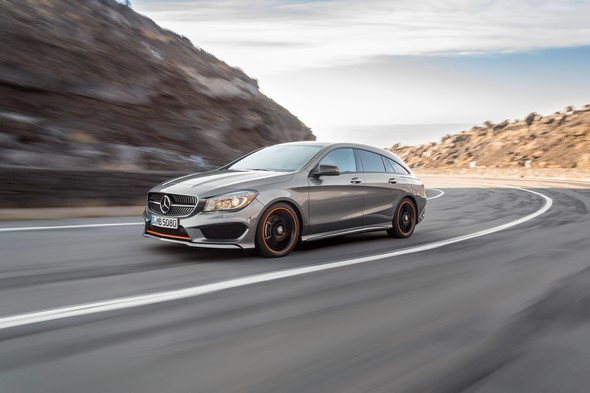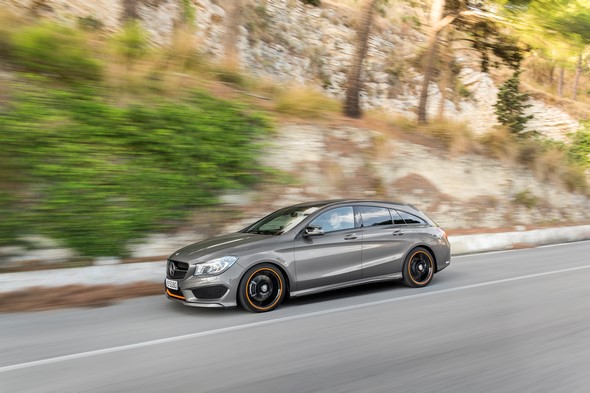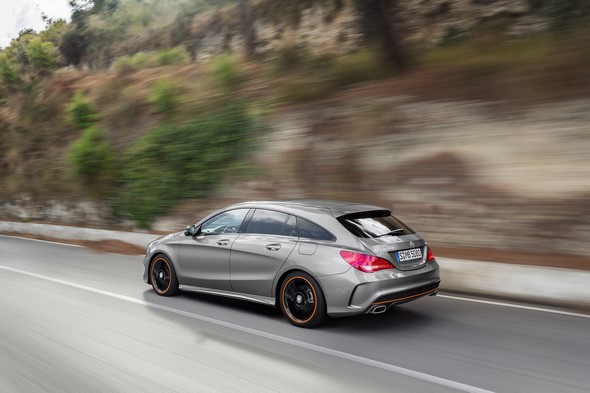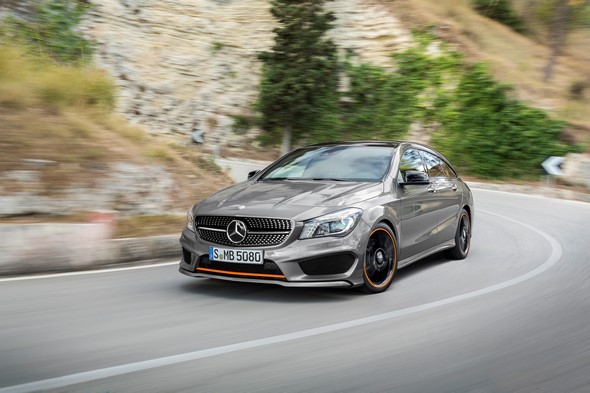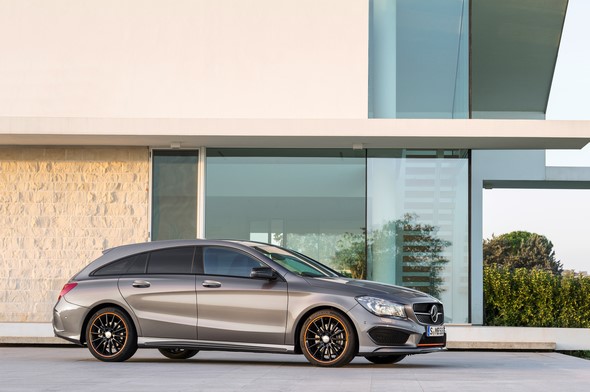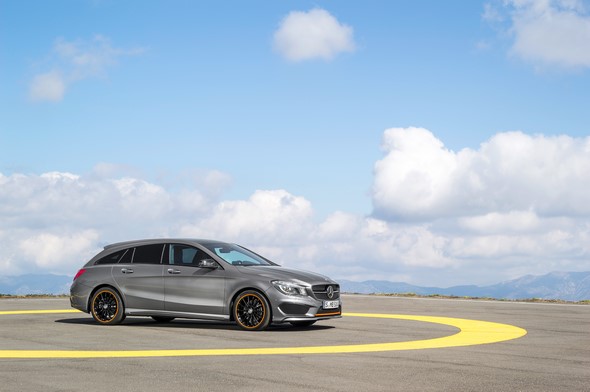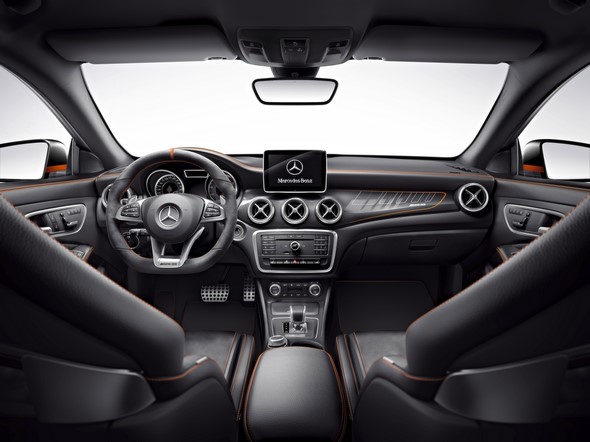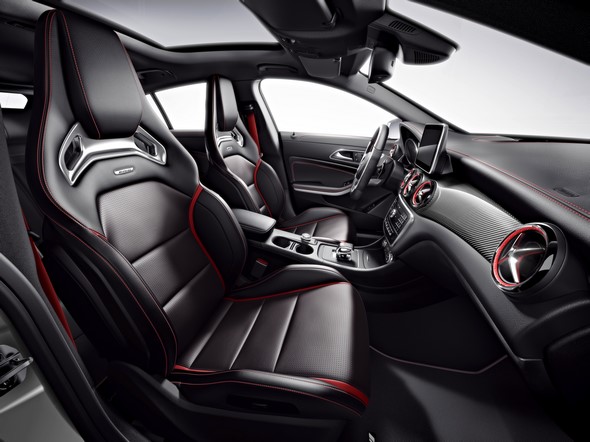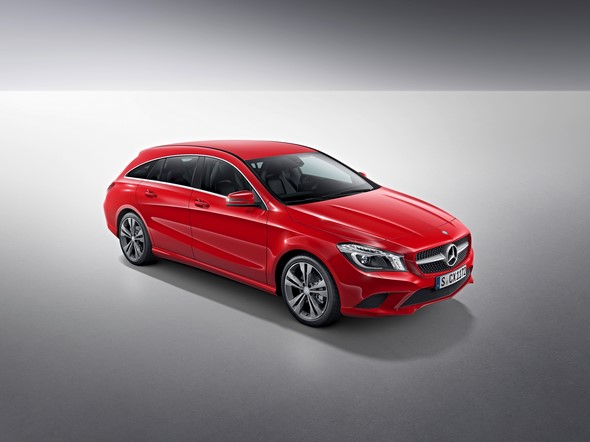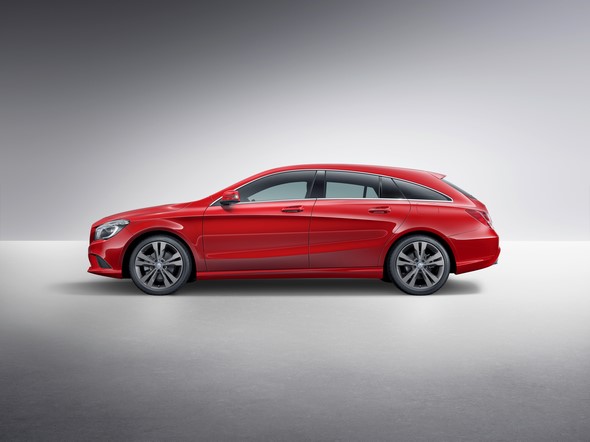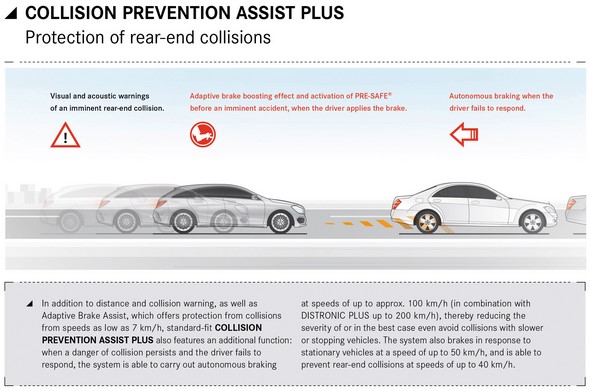Mercedes-Benz CLA Shooting Brake

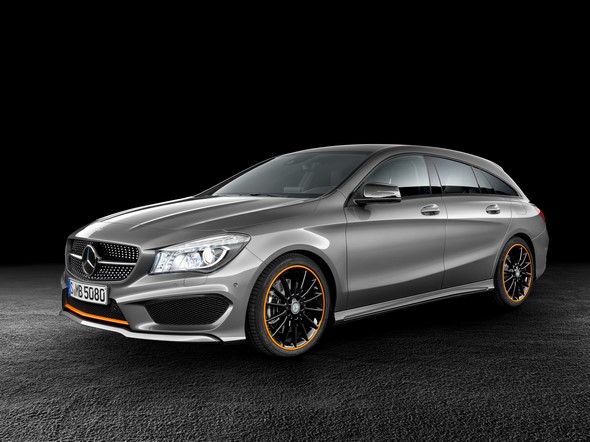
Beauty in its most practical guise
Breathtakingly sporty proportions and a powerfully dynamic design idiom with sensuously shaped surfaces lend the CLA Shooting Brake an unmistakable appearance.
The elongated coupé-style roof contour line, the low greenhouse and the sweep of the high beltline are the key design features of its distinctive profile, as is the gentle downward slope of the roof line, which makes for significantly more headroom than in the four-door coupé.
The CLA Shooting Brake (length/width/height: 4630/1777/1435 mm) will initially be available with a choice of two diesel and four petrol engines as well as with 4MATIC all-wheel drive.

The first models will go to customers towards the end of March 2015. “With the CLA Shooting Brake our compact-car family has grown to five models.
The huge breadth of the range, which also includes all-wheel drive and AMG versions, is a fundamental reason for the impressive success story that is the new compact generation – way over a million cars have already been delivered to customers”, said Dr Dieter Zetsche, Chairman of the Board of Management of Daimler AG and Head of Mercedes-Benz Cars.
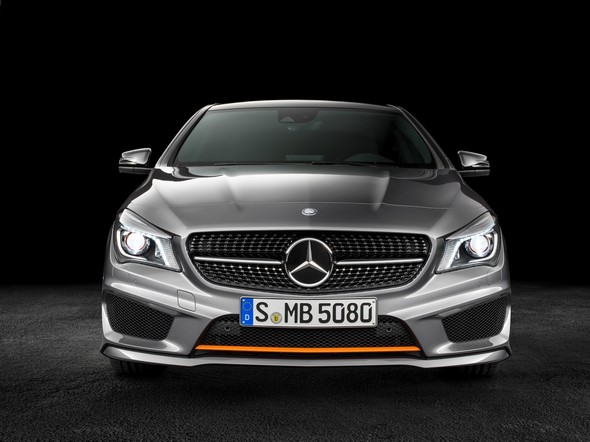
The range, which now includes five models, covers an extremely wide spectrum: with the spacious B-Class Sports Tourer, the youthfully dynamic A-Class, the avant-garde CLA-Class Coupé and the compact GLA-Class SUV, we cater for a host of different customer requirements in this segment,” adds Ola Källenius, Member of the Board of Management of Daimler AG, responsible for Mercedes-Benz Cars Marketing & Sales.
“The CLA Shooting Brake is aimed at active customers who want a car outside the mainstream, with a unique design, which impresses with a high utility value.”
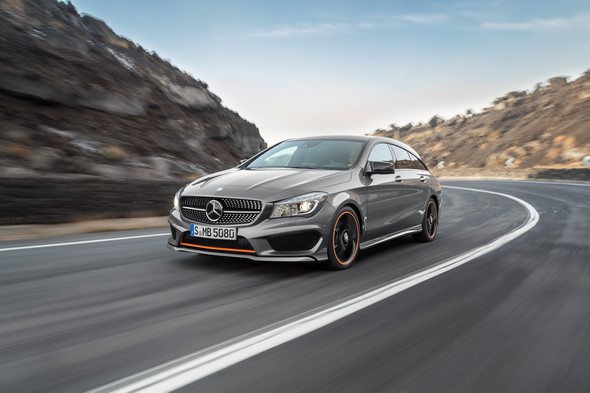
“The highlights include exemplary aerodynamics, state-of-the-art engines, innovative assistance systems and informative telematics services as well as allergy-friendliness”, emphasises Prof Dr Thomas Weber, Member of the Daimler Board of Management responsible for Group Research and Head of Mercedes-Benz Cars Development.
“Like all the models in the compact model series the CLA Shooting Brake also bears the quality seal of the European Centre for Allergy Research Foundation (ECARF) for a scientifically tested high level of allergy-friendliness.”
The guiding principle behind the designers’ work was that of sensual purity as an expression of modern luxury.
“The new CLA Shooting Brake offers a contemporary interpretation of sensual purity and represents the perfect synthesis between the emotionality of a coupé and the intelligence of a shooting brake”, explains Gorden Wagener, Head of Design at Daimler AG.
“The styling of our CLA Shooting Brake is extremely progressive as well as unmistakable. Once again, we have created a whole new class of vehicle.”
The thrilling design details of the limited-edition OrangeArt Edition special model ensure that it brings an exciting note to the market launch.
Orange highlight rings around the bi-xenon headlamps ensure that they stand out in spectacular style. The rim flanges of the AMG light-alloy wheels are painted in orange on the OrangeArt Edition.
Orange/black sports seats and orange contrasting topstitching help to define the interior.
As spacious as they come: Beauty in its most practical guise
The elegantly long drawn-out Shooting Brake tail end, in conjunction with the variability that this offers, guarantees exceptional recreational value without compromising on the CLA’s aspiration to represent design at its best.
At the same time, at 94.7 cm, the effective headroom in the rear is 4 cm higher than it is in the four-door CLA. Access to the second row of seats is also even easier due to the larger door cut-outs.
Spaciousness is one of the strengths of the Shooting Brake. The load compartment offers a capacity that ranges from 495 to 1354 litres (when loaded up to the upper edge of the rear seat backrests or loaded to the roof with the rear bench seat folded down, respectively).
If the rear seats are moved into the more steeply raked “cargo” position, the load capacity increases to 595 litres while still leaving space for five occupants.
The width of the luggage compartment, at up to 1328 mm, is leading in this segment.
Clever little details, including the magnetic catch on the through-loading flap in the rear-seat backrest for long items, such as skis, are further typical examples of this carefully thought-out concept.
Options such as the electrically operated EASY-PACK tailgate or the Load Compartment package help to enhance convenience and variability when using the load compartment.
The CLA Shooting Brake impresses with superb aerodynamics and with a cd value of 0.26 it is top of its segment.
The drag area of Cd x A, a decisive factor when it comes to wind resistance, is 0.57 m2 on the CLA Shooting Brake.
The engine range available with the CLA Shooting Brake is extensive right from the start of sales, comprising two diesel and four petrol units.
All engines impress with their agile performance, low noise levels and low emissions. The CLA 200 CDI,
with an output of 100 kW (136 hp), is particularly efficient: it has a top speed of 215 km/h and a combined consumption figure of just 3.9 l/100 km, with emissions of 101 g CO2/km.
All versions are equipped as standard with the ECO start/stop function and are Euro 6-compliant.
All-wheel drive is likewise available straight from the market launch, initially in the CLA 250 4MATIC and CLA 250 Sport 4MATIC (features include: dynamic styling, sporty tuning of engine, accelerator and transmission as well as sporty engine sound) and it is of course available in the CLA 45 AMG.
Diesel variants in the guise of the CLA 200 CDI 4MATIC and CLA 220 CDI 4MATIC will follow in September 2015.
| Diesel | CLA 200 CDI | CLA 220 CDI |
| Number of cylinders/arrangement | 4 in-line | 4 in-line |
| Displacement (cc) | 2143 | 2143 |
| Rated output (kW/hp at rpm) | 100/136 at 3200-4000 | 130/177 at 3600-3800 |
| Rated torque (Nm at rpm) | 300 at 1400-3000 | 350 at 1400-3400 |
| Combined fuel consumption from (l/100 km) | (4.2-3.9) 4.4-4.1 | (4.3-4.0) |
| Combined CO2 emissions from (g/km) | (111-101) 115-108 | (112-105) |
| Efficiency class | (A+) A+ | (A+) |
| Acceleration 0-100 km/h (s) | (9.9) 9.9 | (8.3) |
| Top speed (km/h) | (215) 215 | (228) |
| Price from (euros)* | 34,539.75 | 39,061.75 |
Figures for version with 7G-DCT dual clutch transmission in parentheses;
*in Germany, incl. 19% VAT.
| Petrol | CLA 180 | CLA 200 | CLA 250 | CLA 250 4MATIC | CLA 45 AMG 4MATIC |
| Number of cylinders/arrangement | 4 in-line | 4 in-line | 4 in-line | 4 in-line | 4 in-line |
| Displacement (cc) | 1595 | 1595 | 1991 | 1991 | 1991 |
| Rated output (kW/hp at rpm) | 90/122 at 5000 | 115/156 at 5300 | 155/211 at 5500 | 155/211 at 5500 | 265/360 at 6000 |
| Rated torque (Nm at rpm) | 200 at 1250-4000 | 250 at 1250-4000 | 350 at 1200-4000 | 350 at 1200-4000 | 450 at 2250-5000 |
| Fuel consumption (combined) from (l/100 km) | 6.0-5.5 (5.6-5.3) | 6.0-5.6 (5.6-5.3) | (5.7-5.5) | (6.8-6.6) [6.8] | (6.9) |
| Combined CO2 emissions from (g/km) | 140-128 (132-124) | 140-130 (132-124) | (132-128) | (156-152) [158] | (161) |
| Efficiency class | B (B) | B (B) | (B) | (C) [C] | (C) |
| Acceleration 0-100 km/h (s) | 9.4 (9.3) | 8.8 (8.7) | (6.9) | (6.8) [6.8] | (4.7) |
| Top speed (km/h) | 210 (210) | 225 (225) | (240) | (240) [240] | (250)* |
| Price from (euros)** | 29,809.50 | 32,725 | 39,746 | 41,947.50 [45,577] | 57,268.75 |
Figures for version with 7G-DCT dual clutch transmission in parentheses (in square brackets: CLA 250 Sport 4MATIC); *Electronically limited; **In Germany, incl. 19% VAT.
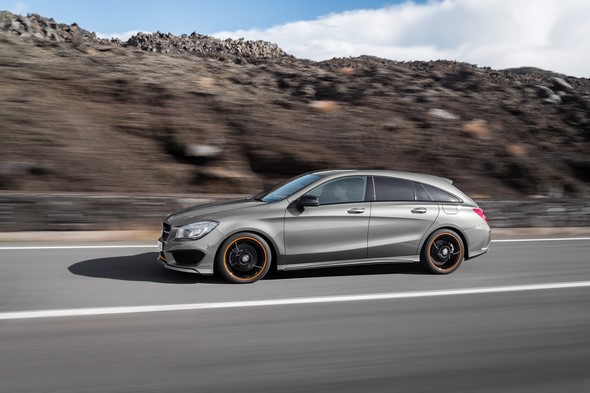
Design: Sharp contours and sensuous surfaces
Many of the detailed elements of the CLA Shooting Brake, too, such as its frameless side windows, appear to define it as a coupé, yet at the same time it offers the variability and practicality of an estate car.
And with its long bonnet, sleek window profile with integral rear quarter window and the gentle downward slope of its roof as it flows to the rear, it demonstrates the same crouching posture as the CLS Shooting Brake.
The long sweep of the roof right to the rear of the car means that it offers more headroom in the back than the four-door CLA coupé model, as well as being easier to get into.
The interplay between sharply defined lines and large surface expanses gives rise to some exciting and characteristic light effects, resulting in a unique look that sets the CLA Shooting Brake quite apart from other vehicles in related segments.
The sporty design of its front section gives the CLA its typical look. Among the striking features that contribute to this characteristic dynamic look are the powerdomes on the bonnet that are such a hallmark of Mercedes coupés, and the diamond radiator grille with a central Mercedes star.
The way the bonnet is embedded into the front end makes it appear longer and, in conjunction with the upright radiator grille and the prominent V-shape of the front end, gives the car its crouching posture.
The arrangement of the light modules and LEDs behind the headlamp lenses gives rise to the characteristic “eyebrow” effect for the daytime running lamps and indicators.
The sleek greenhouse, the elongated roof contour line, the high beltline with low side windows and an additional quarter window, plus the D-pillar that tapers towards the rear, are the particular styling elements of the CLA Shooting Brake seen in profile.
Two character lines define this profile: the new, modern interpretation of the “dropping line”, together with a further separate swell to the flank above the “dropping line”.
This supports the D-pillar, which in turn continues the line round to the tailgate. The precise lines and three-dimensional effect of the side design create a sinewy, animated play of light and shadow.
The broad emphasis of the rear end conveys a sense of power, in an interplay of tense, muscular volume and sharply defined edges.
The sloping roof line, the pronounced curve of the rear window and tailgate and the distinctive look of the rear end as a whole give the CLA Shooting Brake an unmistakable flair of its own.
The narrowing of the car at the D-pillars, in conjunction with the broad shoulder muscle over the rear wheel arch, adds up to a strikingly athletic look, particularly when seen from the rear.
The elegant arrowhead design of the rear light clusters carries the harmonious flow of the shoulders round from the side to the rear end, the horizontal orientation serving to emphasise the powerful width of the vehicle.
The single-piece rear light units are set neatly into the body. The light functions are presented in an arrowhead arrangement. Aerials are integrated into the sporty roof spoiler.
Interior: high-quality materials and integral seats
The exterior’s progressive, sporty appearance is continued inside the vehicle.
The interior additionally derives a very special quality feel from the design idiom of sensual purity, as well as the selection and combinations of the materials chosen. Special equipment packages include colour-contrasted stitching.
The twin-tube instrument cluster comprises two large round dials, each with a small round dial set inside it. When at rest the needles are in the 6 o’clock position.
The silver-coloured needles are inlaid in red, while the dial faces feature a silver-grey textured surface.
The CLA Shooting Brake features the latest generation of telematics systems. The free-standing display screen features a large screen diagonal of 17.8 cm (7 inches), together with a high-gloss piano-black front panel, a flush-fitting frame in Silvershadow and a fully glazed screen.
Upon request in conjunction with COMAND Online, or as an option for the Audio 20 system, the display is available with an even larger screen diagonal of 20.3 cm (8 inches).
The functions shown on the display combine intuitive operation with attractive images and graphics, thus ensuring a positive user experience that adds to the exceptional design appeal of the interior as a whole.
To underline the sporty character, the CLA Shooting Brake boasts integral seats at the front and rear. Luxury seats with a separate head restraint are available on request in the Urban design and equipment line.
The rear bench seat emphasises the outer seats (2+1-seater). Colour-coordinated contrasting topstitching is available based on the chosen equipment.
The ambient lighting system encompasses a total of 13 light sources in the interior, among them a light in the opening between the head restraint and the backrest.
The ambient lighting system is available as an option with different colours: any of twelve colour schemes can be selected to suit taste and mood, helping to conjure up an individual atmosphere in the interior.
The optional panoramic sliding sunroof with its large glazed area provides for an especially bright and friendly ambience in the interior.
It comprises an electrically operated glass sliding roof for individual ventilation of the interior, together with a mesh wind deflector. This reduces both draughts and wind noise when the roof is open.
Safety: autonomous braking if a risk of collision is detected
The CLA Shooting Brake features COLLISION PREVENTION ASSIST PLUS as standard. This assistance system extends the functionality of COLLISION PREVENTION ASSIST by the addition of autonomous braking to reduce the risk of rear-end collisions.
If the driver fails to act when a risk of collision is detected, despite the warning lamp in the instrument cluster and the intermittent acoustic alert, the system will automatically trigger braking.
The vehicle speed is thus already significantly reduced. Depending on the relative speed, this intervention may be enough to avoid a rear-end collision with vehicles that are driving more slowly, stopping or stationary, or significantly mitigate its severity.
Also fitted as standard is the drowsiness detection system ATTENTION ASSIST. Operating within an extended speed range (60 to 200 km/h), it uses a five-stage bar display to visualise the driver’s current attention level.
“Mercedes connect me”: Accident Recovery, Maintenance Management and Breakdown Management
“Mercedes connect me” connects the CLA Shooting Brake with the world around it. The communications module that is available as standard in certain European countries makes it possible to use the Mercedes connect me range of Standard Services.
Available services include, for example, Accident Recovery, Maintenance Management and Breakdown Management. In an accident, the Mercedes-Benz emergency call system automatically connects the occupants with the Mercedes-Benz Emergency Call Centre and sends the position and condition of the vehicle to the rescue operations centre. A rescue vehicle can then be dispatched immediately. The system works automatically, but can also be triggered manually.
The optionally available Remote Online facility allows the customer to connect to their vehicle from anywhere and at any time via “connect.mercedes.me” and, for example, to use their smartphone to find out how full the tank is.
Success story: the compact car family from Mercedes-Benz
The new CLA Shooting Brake is the fifth member to join the Mercedes-Benz compact car family. And what a successful family it is: in 2014 some 463,152 A- and B-Class as well as CLA and GLA cars were sold, which is more than ever before. The biggest markets for the compact models are Germany, the UK and the USA.
The introduction of the new compact car models has seen the Mercedes-Benz brand become palpably younger in appeal – around the world, the average age of its customers has fallen.
Globally, over a million cars of the new generation of compact models are now in customer hands, including over 150,000 CLA models.
The conquest sales rate for the CLA worldwide stands at around 50 percent. Like the CLA, the CLA Shooting Brake is built at the company’s plant in Kecskémet, Hungary.
Mercedes management on the CLA Shooting Brake
“Fifth chapter of a success story”
“With the CLA Shooting Brake our compact-class family has grown to five models. The huge breadth of the range, which also includes all-wheel drive and AMG versions, is a fundamental reason for the impressive success story that is the new compact generation – well over a million cars have already been delivered to customers.”
Dr Dieter Zetsche, CEO of Daimler AG and Head of Mercedes-Benz Cars
„As well as the many technical highlights which characterise our Shooting Brake, like all the models in the compact model series it bears the quality seal of the ECARF (European Centre for Allergy Research Foundation) for scientifically tested high allergy-friendliness. Mercedes-Benz is the only automotive manufacturer to earn the ECARF seal.”
Thomas Weber, Member of the Daimler Board of Management, responsible for Group Research and Head of Mercedes-Benz Cars Development
“The CLA Shooting Brake is aimed at active customers who want a car outside the mainstream, with a unique design, which impresses with a high utility value. With the spacious B-Class Sports Tourer, the youthfully dynamic A-Class, the avant-garde CLA Coupé and the compact GLA SUV, we cater for a host of different customer wishes in this segment.”
Ola Källenius, Member of the Daimler Board of Management, responsible for Mercedes-Benz Cars Marketing & Sales
“The new CLA Shooting Brake offers a contemporary interpretation of sensual purity and represents the perfect synthesis between the emotionality of a coupé and the intelligence of a shooting brake. The styling of our CLA Shooting Brake is extremely progressive as well as unmistakable. Once again, we have created a whole new vehicle class.”
Gorden Wagener, Head of Design at Daimler AG
Equipment and appointments
From sporty to stylish
With the two design and equipment lines Urban and AMG Line plus the three packages Night, Exclusive and AMG Exclusive, the CLA Shooting Brake can be configured highly individually.
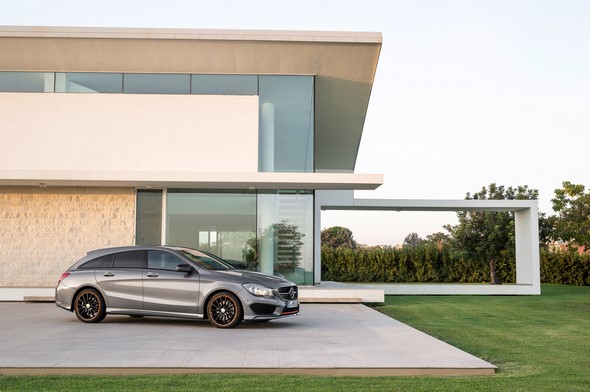
Added to this there are the limited special model OrangeArt Edition plus the sports model available as the CLA 250 4MATIC. Practical optional extras like the electrically operated EASY PACK tailgate enhance the utility value.
The thrilling design details of the limited-edition OrangeArt Edition special model ensure that it brings an exciting note to the market launch.
Orange trim in conjunction with selected equipment features, such as the AMG Line and Night package, emphasises the sporty flair of this model.
A distinctive sporty look is also ensured by 45.7 cm (18-inch) AMG multi-spoke light-alloy wheels, painted in black with an orange rim flange, together with orange highlights on the front and rear aprons.
The bi-xenon headlamps feature orange highlight rings.
The interior, too, is imbued with a sense of exclusive dynamism, thanks to the Exclusive package, sports seats with leather/DINAMICA microfibre upholstery in black/orange and orange contrasting topstitching, along with black seat belts with accentuating orange stripes.
The 3-spoke multifunction sports steering wheel in leather, the instrument panel in ARTICO man-made leather and the aluminium trim with honeycomb-pattern grain, as well as fine detailing such as the recurring orange contrasting topstitching in the interior, convey a sense of delight in the unusual.
The sports model: a more dynamic look and even more fun and the wheel
The CLA 250 4MATIC is also available as a sports model on request. A more dynamic appearance from every perspective comes courtesy of the powerful AMG bodystyling, a diamond radiator grille with pins in chrome and red trim on the front and rear apron.
The lowered comfort suspension engineered by AMG with the Direct-Steer system improves handling and boosts driving enjoyment.
Also contributing to this are the sporty tuning of the engine, accelerator and transmission plus the sporty engine sound. 45.7 cm (18-inch) 5-spoke light-alloy wheels, perforated front brake discs and front and rear red brake callipers with Mercedes-Benz lettering round off the striking exterior.
Sports seats in ARTICO man-made leather/DINAMICA microfibre plus the multifunction sports steering wheel with a flattened bottom section and red designo seat belts add sporty highlights in the interior.
The seats, the door armrests and the centre console all feature red contrasting topstitching. Further highlights are the front and rear door sill panels in aluminium plus the brushed stainless steel sports pedals with rubber studs.
The design and equipment lines: enhanced inside and out
The CLA Shooting Brake is furthermore also available with either of the two design and equipment lines Urban and AMG Line, in each case with numerous line-specific details for both the exterior and interior.
The AMG Line augments the sportiness and exclusivity of the CLA Shooting Brake.
This design and equipment line includes, amongst other features, a more dynamic exterior with AMG bodystyling, 45.7 cm (18-inch) AMG 5-twin-spoke light-alloy wheels and a two-pipe exhaust system with chrome tailpipe trim.
The interior also exudes a sporty flair, with sports seats in ARTICO man-made leather/DINAMICA microfibre, a multifunction sports steering wheel with flattened bottom section and a leather-upholstered shift lever.
The lowered sports suspension enhances handling as well as driving enjoyment.
The Urban design and equipment line uses selected exterior and interior equipment and appointment features in a similar way to emphasise the vehicle’s dynamic appeal, whilst also allowing further individualisation.
Dynamic highlights of the exterior include, for example, a diamond radiator grille with high-gloss black pins, the 45.7 cm (18-inch) 5-twin-spoke light-alloy wheels and the two-pipe exhaust system with chrome-plated tailpipe trim.
Contributing to the sporty character in the interior are the sports seats with contrasting topstitching, a multifunction leather steering wheel with perforated grip area and a wave-look trim element.
The packages: from sportily expressive to stylishly exclusive
The Night package lends the car a sportily expressive character with striking exterior equipment features. It includes selected design elements in black.
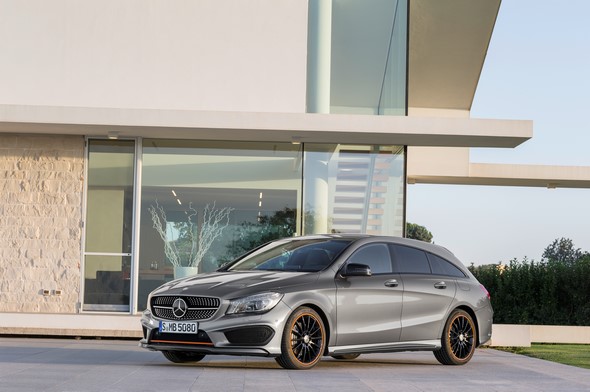
The diamond radiator grille sports pins and a louvre in high-gloss black (in conjunction with Urban) or pins in chrome (in conjunction with AMG Line). The 45.7 cm (18-inch) high-sheen light-alloy wheels, exterior mirrors and window weatherstrip also come in black.
Dark-tinted glass from the B-pillar to the rear protects against prying eyes and simultaneously emphasises the sporty character. The Night package builds on the Urban or AMG Line equipment and appointments.
The Exclusive package comprises a stylishly coordinated combination of high-quality interior equipment and appointments.
Highlights include heated sports seats with 4-way lumbar support, which, like the multifunction steering wheel and gear lever, are finished in leather.
The instrument panel and door centre panel are trimmed with matching ARTICO man-made leather. Contrasting topstitching plus aluminium and silver chrome design elements also help to create an exclusive ambience.
There are also lots of practical details such as the multifunction holder, the extended central locking with summer opening and closing for the side windows and panoramic sliding sunroof, and there is a 12 V socket in the rear.
The AMG Exclusive package builds on the AMG Line design and equipment line. The selected interior details augment the exclusivity, individuality and sportiness of the CLA Shooting Brake.
Features also include heated sports seats with 4-way lumbar support, whose RED CUT black leather upholstery with red contrasting topstitching sets striking highlights.
To match them, the instrument panel and door centre panels as well as the armrests in the doors are trimmed with ARTICO man-made leather.
The multifunction sports steering wheel in leather with a flattened bottom section and perforated grip areas and the gearshift lever trimmed in perforated leather emphasise the sporty character.
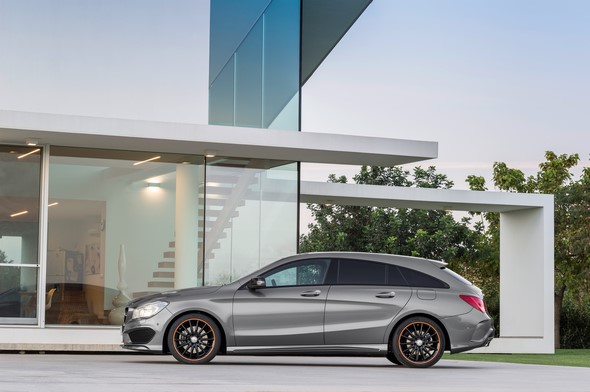
Red contrasting topstitching is also to be found on all these elements, indicating a loving attention to detail. A further shining example is set by the brushed stainless steel sports pedals with rubber studs.
Practical details such as the multifunction holder, which divides the open stowage compartment in the centre console into two compartments for safely storing beverage cans and containers and at the same time offers a stowage facility for parking/plastic cards and coins, the adjustable armrest on the centre console and the 12 V socket in the rear are also part of the standard specification with the AMG Exclusive package.
The optional extras: from draught-free to full power
The optional panoramic sliding sunroof with its large glazed area provides for an especially bright and friendly ambience in the interior.
It comprises an electrically operated glass sliding roof for individual ventilation of the interior, together with a mesh wind deflector. This reduces both draughts and wind noise when the roof is open.
Options such as the electrically operated EASY-PACK tailgate or the Load Compartment package help to enhance convenience and variability when using the load compartment.
Apart from the “cargo” positioning option for the rear-seat backrests, the Load Compartment package includes a collapsible box, a 12 V socket and an additional stowage net at the side of the load compartment.
Available on request and for an even more exclusive ambience there is also the load compartment floor with aluminium strips as well as non-slip inserts and a lockable aluminium handle.
A folding trailer coupling with ESP® trailer stabilisation is available too.
Further practical optional extras include the KEYLESS-GO starting function – with this the vehicle is started by pressing the starter button – and also KEYLESS‑GO.
This access and drive authorisation system, which also incorporates the KEYLESS-GO starting function, allows the vehicle to be opened, started and locked simply by carrying the electronic key with you.
Under the microscope: the success story
Over a million new compact cars
The new CLA Shooting Brake is the fifth member to join the Mercedes-Benz compact car family. And what a successful family it is: in 2014 some 463,152 A- and B-Class, plus CLA and GLA cars were sold, which was more compact cars than ever before. Sales were up 24.7%.
The compact models thus played a major role in the most successful year yet in the company’s history. Mercedes-Benz delivered 1,650,010 cars to customers (+12.9%) and thus achieved the fourth record year in succession.
In 2014 every month was a record month – including December, with 163,171 units sold (+17.2%). The Stuttgart company ended the past year with the strongest month for sales and the best quarter (454,854 units) in its history.
Around the world, at the end of 2014 over a million cars of the new generation of compact models were in customer hands, including over 150,000 CLA models.
The conquest sales rate for the CLA worldwide stands at around 50 percent. Like the CLA, the CLA Shooting Brake is built at the company’s plant in Kecskémet, Hungary.
The biggest markets for the compact models are Germany, the UK and the USA.
The introduction of the new compact car models has seen the Mercedes-Benz brand become palpably younger in appeal – around the world, the average age of its customers has fallen.
Under the microscope: new car segments
Conceptional creativity
With the CLA Shooting Brake, Mercedes-Benz is bringing to the executive segment a concept which was invented within the company and celebrated its launch in 2012 with the CLS Shooting Brake.
Both Shooting Brake models are an expression of conceptional creativity and thus underline the leading role played by Mercedes-Benz when it comes to design: where their proportions are concerned they are clearly a coupé, yet with five doors and the roof continuing back to the tail end they offer considerable new possibilities.
This is how the idea of a four-door coupé is innovatively followed through. It celebrated its world premiere with the first CLS in 2004 and in 2013 it was successfully included in the compact medium-size category in the form of the CLA.
In the meantime other manufacturers have also taken up the concept of the four-door coupé.
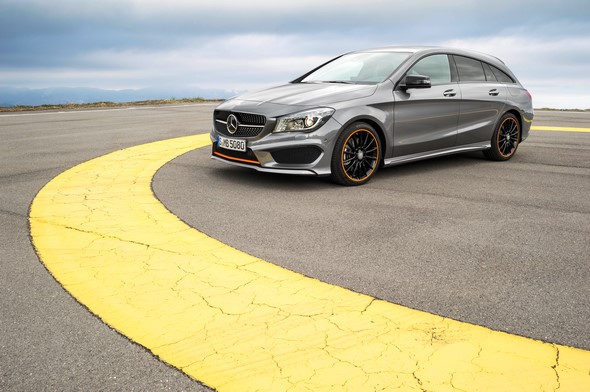
This gives us reason to believe that the five-door Shooting Brake will also attract imitators and that the sporty space concept will also mature into its very own market category.
It places the Shooting Brake in the impressive series of market-shaping new vehicle concepts which were developed at Mercedes-Benz.
Earlier examples are the SLK, which in 1996 was the first roadster with a lowerable steel roof and shaped an entire category, and the M-Class of 1998 as the first premium SUV.
Based on this, the ML 55 AMG from 2001 was an exemplary first SUV sports car. Another first of its kind was the premium estate of the 123 model series (1977) – today an integral part in the model range of virtually all premium manufacturers.
About the term: this is how the name Shooting Brake arose
Break or Brake used to be the name given to carts which were fitted with light, often variable attachments for carrying everything that was needed when hunting.
This type of car, which was used to go shooting, was called a Shooting Brake or Shooting Break.
In particular in the 60s and 70s there were experiments with motorised Shooting Brakes, especially in Great Britain – exclusive two-door sports cars, which blended the luxury and style of a coupé with more room for luggage and a large tailgate.
Design
Sharp contours and sensuous surfaces
Three years ago Mercedes-Benz realised a sports car in a new shape in the form of the CLS Shooting Brake – with five seats and a large tailgate.
The founders of this vehicle concept are now following it up with a second Shooting Brake model exuding stylish sporty flair and modern luxury, with lines that are the essence of sensual purity.
Many of the detailed elements of the CLA Shooting Brake, such as its frameless side windows, appear to define it as a coupé, yet at the same time it offers the variability and practicality of an estate car.
And with its long bonnet, sleek window profile with integral rear quarter window and the gentle downward slope of its roof as it flows to the rear, it demonstrates the same crouching posture as the CLS Shooting Brake.
The long sweep of the roof right to the rear of the car means that it offers more headroom in the back than the four-door CLA coupé model, as well as being easier to get into.
The interplay between sharply defined lines and large surface expanses gives rise to some exciting and characteristic light effects, resulting in a unique look that sets the CLA Shooting Brake quite apart from other vehicles in related segments.
The sporty design of its front section gives the CLA its typical look. Among the striking features that contribute to this characteristic dynamic look are the powerdomes on the bonnet that are such a hallmark of Mercedes coupés, and the diamond radiator grille with a central Mercedes star.
The way the bonnet is embedded into the front end makes it appear longer and, in conjunction with the upright radiator grille and the prominent V-shape of the front end, gives the car its crouching posture.
The arrangement of the light modules and LEDs behind the headlamp lenses gives rise to the characteristic “eyebrow” effect for the daytime running lamps and indicators.
The sleek greenhouse, the elongated roof contour line, the high beltline with low side windows and an additional quarter window, plus the D-pillar that tapers towards the rear, are the particular styling elements of the CLA Shooting Brake seen in profile.
Two character lines define this profile: the new, modern interpretation of the “dropping line”, together with a further separate swell to the flank above the “dropping line”.
This supports the D-pillar, which in its turn continues the line round to the tailgate. The precise lines and three-dimensional effect of the side design create a sinewy, animated play of light and shadow.
The broad emphasis of the rear end conveys a sense of power, in an interplay of tense, muscular volume and sharply defined edges.
The sloping roof line, the pronounced curve of the rear window and tailgate and the distinctive look of the rear end as a whole give the CLA Shooting Brake an unmistakable flair of its own.
The narrowing of the car at the D-pillars, in conjunction with the broad shoulder muscle over the rear wheel arch, adds up to a strikingly athletic look, particularly when seen from the rear.
The elegant arrowhead design of the rear light clusters carries the harmonious flow of the shoulders round from the side to the rear end, the horizontal orientation serving to emphasise the powerful width of the vehicle.
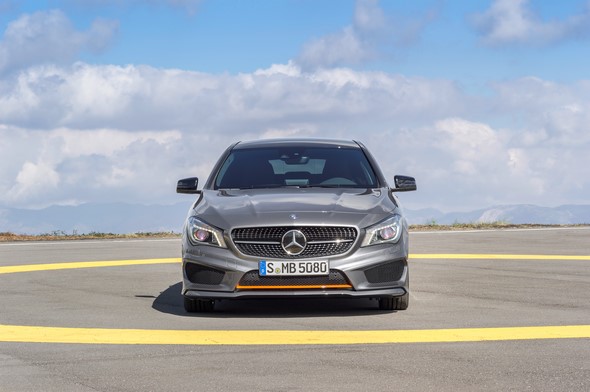
The single-piece rear light units are set neatly into the body and reflect the relationship of the CLA Shooting Brake to both the four-door Coupé model CLA and to the larger CLS Shooting Brake.
The light functions are presented in an arrowhead arrangement. Aerials are integrated into the sporty roof spoiler.
Interior: high-quality materials and integral seats
The exterior’s progressive, sporty appearance is continued inside the vehicle.
The interior additionally derives a very special quality feel from the design idiom of sensual purity, as well as the selection and combinations of the materials chosen.
Special equipment packages include colour-contrasted stitching.
The twin-tube instrument cluster comprises two large round dials, each with a small round dial set inside it. When at rest the needles are in the 6 o’clock position.
The silver-coloured needles are inlaid in red, while the dial faces feature a silver-grey textured surface.
Another highlight is the new generation of 3-spoke steering wheels in different variants, including a multifunction sports steering wheel with flattened bottom section and red or black topstitching.
The instrument panel incorporates five round vents. The outer rings of the round vents on all models have a high-quality silver chrome galvanised finish.
The airflow direction is governed by a galvanised insert that reveals a meticulous attention to detail. The CLA Shooting Brake features the latest generation of telematics systems.
The free-standing display screen features a large screen diagonal of 17.8 cm (7 inches), together with a high-gloss piano-black front panel, a flush-fitting frame in Silvershadow and a fully glazed screen.
In combination with COMAND Online the screen is even larger (screen diagonal 20.3 cm/8 inches); optionally this display is also available for the Audio 20.
The functions shown on the display combine intuitive operation with attractive images and graphics, thus ensuring a positive user experience that adds to the exceptional design appeal of the interior as a whole.
To underline the sporty character, the CLA Shooting Brake boasts integral seats at the front and rear. Luxury seats with a separate head restraint are available on request in the Urban design and equipment line.
The rear bench seat emphasises the outer seats (2+1-seater). Colour-coordinated contrasting topstitching is available based on the chosen equipment.
The ambient lighting system encompasses a total of 13 light sources in the interior, among them a light in the opening between the head restraint and the backrest.
The ambient lighting system is available as an option with different colours: any of twelve colour schemes can be selected to suit taste and mood, helping to conjure up an individual atmosphere in the interior.
The CLA Shooting Brake – like all the models in the compact model series – also bears the quality seal of the European Centre for Allergy Research Foundation (ECARF) for a scientifically tested high level of allergy-friendliness.
Mercedes-Benz is the only automotive manufacturer to earn the ECARF seal.
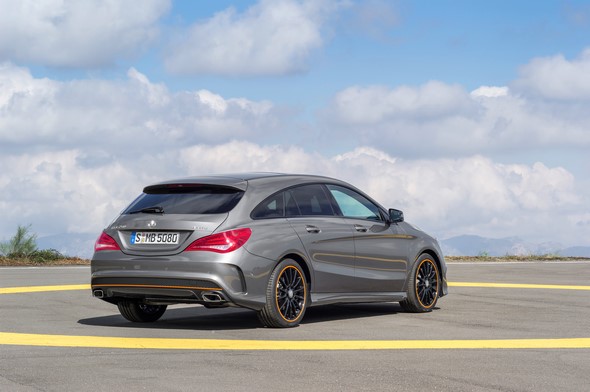
Under the microscope: the allergy label ECARF
Emphasis on clean air
All the new passenger car models from Mercedes-Benz bear the Seal of Quality of the European Centre for Allergy Research Foundation (ECARF).
This makes Mercedes-Benz the only vehicle manufacturer to bear this seal. The ECARF Seal of Quality is used by ECARF to designate products that have been scientifically tested and proven to be suitable for allergy sufferers.
Alongside comprehensive testing for inhaled and contact allergens, Mercedes-Benz has been testing the interior emissions of all its model series for 23 years now.
The new CLA Shooting Brake is the latest Mercedes-Benz model to have received the ECARF Seal of Quality. The conditions of certification have been met by all model series launched in recent years, from the A-Class to the S-Class.
The criteria behind the ECARF Seal are also included in the specifications book for all future Mercedes-Benz passenger car model series.
The emphasis on clean air applies for Mercedes-Benz in three particular areas: along with the avoidance of allergens, the concern is to reduce interior emissions and to keep odours at a consistently pleasant level.
“We have been measuring the interior emissions of our vehicles since 1992 and have been able to make steady progress in reducing them”, according to Dr Jörg Breuer, Director Certification, Regulatory Affairs & Environment at Daimler AG.
“We have a strict internal limit these days, which has to be met by all Mercedes-Benz passenger cars – by our compact vehicles and roadsters but equally by our large estates and SUV models.”
There are currently a dozen or more experts working in the development and materials technology area on the interior air quality of new models.
This year, the team will also be moving into a new test centre at the Mercedes-Benz Technology Centre in Sindelfingen – a fact which also serves to emphasise the importance given to this topic.
Even in the early stages of the development of a vehicle, up to six years before it goes into production, the minimisation of interior emissions is a factor helping to define the materials concept.
As far back as 1996, Mercedes-Benz’s own internal standards set emission levels for materials used for components in the passenger compartment and boot.
Today designers and developers can make their choice from a database of around 8000 interior materials that have been approved by the specialist department.
Interior emissions: extensive testing of many components and all cars
Just before a new model goes into series production, its interior emissions are tested in a series of complex procedures.
This type of analysis has been conducted by Mercedes-Benz since 1992. Component assessment involves the testing of numerous parts from each equipment variant of a model series – door panels and seats as well as the roof liner and trim.
In order to ensure that a realistic impression is gained, the team do not use specially produced sample components but standard production components produced using the tools that will be subsequently used for series production.
The testing procedure prescribes adherence to the VDA 276 standard as laid down by the German Motor Industry Association – the components are stored and measured in a test chamber 1 m3 in size at a defined temperature, humidity level and air circulation rate.
Air samples are then extracted and used to measure the quality and quantity of gaseous substances in the air.
The examination of the vehicle as a whole involves an even more complex process. The necessary preparation of the vehicle alone, in other words the installation of the measuring equipment, takes the well-rehearsed team three quarters of an hour, while the measurements themselves last a full week.
The test chamber is lined with stainless steel in order to prevent it giving off emissions of its own. Large radiant heaters are used to simulate the sun and heat up the interior of the vehicle, since for physical reasons emissions are greater under the influence of heat.
The solar irradiance is measured by special devices called pyranometers.
Inside the vehicle, as many as ten sensors are used to record the temperature in various areas, for example on the top of the dashboard.
A rotating paddle stirs up the air inside the vehicle to ensure an even mix. Overall emissions within the vehicle are calculated with the help of a rack-mounted flame ionisation detector.
The rack projects into the vehicle interior over the opened window on the driver’s side, which has been made airtight and emission-neutral with the aid of aluminium foil.
If taking measurements according to test method FAT AK 26, for example, measuring can begin as soon as a temperature of 65 degrees Celsius has been reached at the level of the driver’s nose.
Samples of air are extracted from the interior and the air flow directed into a series of test tubes. The chemical composition of the evaporated substances is then analysed in the laboratory.
“We use different sampling techniques for the various categories of substance that we analyse”, explains Hartmut Kovacs, Design for Environment, Head of Interior Emissions at Mercedes-Benz.
“All in all, we take more than 100 samples from each vehicle.” As well as the overall emissions, it is therefore also possible to measure the emissions of individual organic compounds.
The emissions experts also look at a vehicle’s propensity to fogging – in other words the creation of a film of condensable substances on a car’s windscreen: the measuring rack therefore also includes a cooled sheet of glass upon which these less volatile substances, if present, are deposited.
In addition to this static test, a further series of tests are used to evaluate emission activity in the interior of the vehicle while it is in use.
These tests take place with the engine running and the air-conditioning system switched on, with and without air recirculation.
A further touch involves the driver’s door being opened once during each measurement cycle to simulate the driver getting into the vehicle.
ECARF Seal: extensive allergen testing
“In our estimation, Mercedes-Benz currently represents the benchmark in terms of allergen optimisation for vehicles”, according to Professor Dr Torsten Zuberbier, Director of the European Centre for Allergy Research Foundation (ECARF), which is based at the Charité university hospital in Berlin.
In industrialised countries these days, allergic conditions are now the most common form of chronic illness. In Germany, for example, around 30 percent of the population are affected.
One in ten absences from work as a result of sickness is now attributable to an allergy.
But the pollen count is not the only problem to afflict motorists who suffer from allergies: emissions given off by the materials used in the interior or when contact surfaces are touched can also lead to a strong reaction, with symptoms such as swelling and inflammation of the nasal passage, hay fever or asthma.
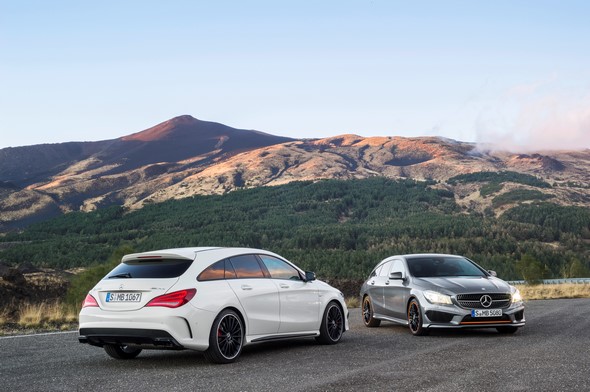
But not in a Mercedes-Benz vehicle: numerous model series from the A- to the S-Class meet the criteria of the allergy label.
The conditions involved are extensive: numerous components from each equipment variant of a vehicle have to be tested for inhaled allergens, for example.
Furthermore, the function of the pollen filter must be tested in both new and used condition.
In addition, tests are undertaken with human “guinea pigs”. Driving tests, for example, were conducted with people suffering from severe asthma, with lung function tests providing information about the impact on the bronchial system.
In addition, all materials that might come in contact with the skin were dermatologically tested. What are known as epicutaneous skin tests were undertaken with test subjects suffering from contact allergies in order to test the tolerance levels for known contact allergens such as chrome-nickel and various pigments.
This involved substances from the interior that were deemed to be potential allergens being applied with plasters to the skin for 72 hours and the reaction to them being evaluated after 48 and then 72 hours.
The air-conditioning filters also have to meet the stringent criteria of the ECARF Seal in both new and used condition: amongst other things the tests measure their retention efficiency with regard to dust and pollen.
Body and aerodynamics
There is strength in serenity
A high body strength is decisive not only for optimum protection of the occupants; it is also the basis for quiet running and low vibration levels.
Both were achieved with lower weight through the use of higher-strength and high-strength sheet steels plus aluminium and through elaborate joining techniques.
A further plus point is the aerodynamics: With a cd value of 0.26 the CLA Shooting Brake sets the benchmark in the compact estate segment.
Even from 60 km/h the wind resistance exceeds the sum of all other types of driving resistance. This motivates the engineers at Mercedes-Benz to achieve optimum values for aerodynamics on each new model.
By way of example, the CLA Coupé with a cd value of 0.23[1] is world champion in this discipline. The CLA Shooting Brake with its estate tail end is no exception here and with cd = 0.26 it also achieves an optimum value in its segment.
Its drag area (cd value x frontal area) of 0.57 m² is also exemplary.
The aerodynamically efficient shape also reduces the occurrence of wind noise, and together with sophisticated seals the interior of the car is thus effectively shielded from wind noise.
Alongside an aerodynamically efficient basic shape of the body, a series of measures also improves the aerodynamics. These include:
- A low A-pillar level with specially adjusted A-pillar geometry
- Aerodynamically optimised exterior mirror housing
- Seals in the front bumper(closed radiator section incl. headlamp section)
- Radiator shutter for on-demand control of the cooling air, partial cover in the radiator grille
- Serrated wheel spoiler with shoulders on the wheel arches of the front wheels
- Comprehensive flow on the underfloor through generous covering of the main floor panel, additional covering in the centre section of the rear axle plus the spring links and an aerodynamically optimised rear silencer with a connecting diffuser
- Aerodynamically graduated roof side and tail lights
A multitude of details also help to reduce the wind noise, for example:
- Frameless doors with a multi-stage sealing concept
- High window insulation due to 5 mm side windows
- Sealing of the rear-end door joints
- Shape-optimised exterior mirrors, which are secured to the door edges
On the full-glass panoramic roof with the sliding sunroof running on the exterior, many wind guidance measures such as a wind deflector, covers and seals with adapted geometry ensure that the noise level is as low as possible when the roof is open.
The wind deflector suppresses the throbbing noises which would usually occur and also facilitate virtually draught-free driving.
Rigid body minimises noises and vibrations
Intelligent lightweight construction through robust, innovative materials (68% consist of higher-strength and ultra-high-strength sheet steels, the bonnet and front wing are made of aluminium), stress-appropriate wall thicknesses and to a certain extent innovative joining techniques such as structural adhesive create the basis for a stable body.
All the sheet metal panels used are galvanised for protection against corrosion.
In addition to the overall vehicle rigidity the connection points between the body and the chassis/drive system are decisive for noise- and vibration-related comfort.
Considerable increases in the introduction rigidity have been achieved, which in turn lead to a reduction of the noise level in the vehicle interior.
For damping the bodyshell’s structure-borne noise, acoustic masses are automatically applied to the body. To reduce the noise impact to the passenger compartment, the insulation of the firewall is designed as a high-quality injection-moulded part.
Compared with deep-drawn components this has the advantage that constant wall thicknesses can be realised and that there is no thinning of the material in the case of large breaks in contours.
Thus the risk of acoustic weak points can be minimised. The irradiation of sound is also minimised by an absorber on the tunnel roof.
It was possible to achieve high standards of noise insulation of the rear through the targeted use of absorbers beneath the seating surface and also in cavities in the body.
The wheel arch lining also dampens noises in a targeted manner.
In order to cut the tyre noise the focus was on the dynamic transfer response of the individual axle structure and steering components and also on the de-coupling capacity of the chassis mounts.
Through a detailed operating vibration and component analysis the affected chassis and steering parts were configured in such a way with regard to their natural frequencies and dynamic rigidities that the occurrence of bursts of noise into the body was significantly lowered.
[1] CLA Blue Efficiency: cd = 0.22
Active safety
Network of supporters
Numerous driving assistance systems offer support in the CLA Shooting Brake and reduce the driver’s workload.
Its standard features include the ATTENTION ASSIST drowsiness detection system and the radar-based COLLISION PREVENTION ASSIST PLUS with Adaptive Brake Assist.
The CLA Shooting Brake boasts COLLISION PREVENTION ASSIST PLUS as standard. The system extends the functionality of COLLISION PREVENTION ASSIST with the addition of autonomous braking to reduce the risk of rear-end collisions.
If the driver fails to act when a risk of collision is detected, despite the warning lamp in the instrument cluster and the intermittent acoustic alert, the system will automatically trigger braking.
The vehicle speed is thus already significantly reduced. Depending on the speed in relation to the vehicle in front, this intervention may be enough to avoid a rear-end collision with vehicles that are driving more slowly, stopping or stationary, or significantly mitigate its severity.
The latest generation also includes the standard-fit ATTENTION ASSIST: Operating within an extended speed range (60 to 200 km/h), it uses a five-stage bar display to visualise the driver’s current attention level.
The system’s sensitivity can be varied via the “Assistance” menu in the instrument cluster. If the “Sensitive” setting is selected, the system warns the driver earlier.
A series of further assistance systems can be added to this:
- Adaptive Highbeam Assist[1]: when vehicles are detected ahead of or oncoming to the vehicle, this system automatically dips the beams and adjusts the range of the headlamps appropriate to the distance. The driver benefits from a longer dipped beam range and does not generally need to switch manually between main and dipped beam.
- Active Parking Assist including PARKTRONIC: makes entering parallel and end-on parking spaces and also leaving parallel parking spaces easier. The electronic PARKTRONIC monitors the front and rear ends during manoeuvring and warns the driver if it detects a risk of collision.
- Intelligent Light System (ILS): with five light functions, automatically adapts to the weather and light conditions and the driving conditions. ILS comprises bi-xenon headlamps with variable light distribution and dynamic headlamp range control for country roads, motorways and heavy fog, active light function, LED daytime running lamps and a headlamp cleaning system.
- Blind Spot Assist: detects vehicles in the critical zone by means of two radar sensors located at the sides at the rear of the vehicle and warns the driver by displaying a red triangle in the exterior mirror. If the turn indicator is actuated the red triangle begins to flash and a warning tone is emitted.
- Lane Keeping Assist: a camera behind the windscreen detects carriageway markings and can recognise if the car is about to leave a detected lane unintentionally.
- Speed Limit Assist: a camera fitted behind the windscreen detects speed limit signs at the roadside and compares this data to information contained in the GPS system or the digital map. The relevant speed limit is then displayed in the instrument cluster.
- Brake Hold function (standard): when stopping, for example at traffic lights, the driver merely has to press the brake pedal slightly more firmly once (and can then take his or her foot off the brake) to keep the brake engaged until moving off again. The brake is released automatically when the driver steps on the accelerator.
- Reversing camera: integrated in the handle strip on the tailgate, the reversing camera features a wide-angle lens. When reverse gear is engaged, the image from the camera is transmitted to the screen of the Audio 20 system or the COMAND system. Static and dynamic guide lines assist the driver during manoeuvring. For protection against soiling the camera only leaves its housing when in use.
- DISTRONIC PLUS: radar-based proximity control supports the driver at speeds between zero and 200 km/h by automatically adjusting the distance from the vehicles in front. In doing so it is able to apply the brakes to bring the vehicle to a complete standstill and also accelerate it again. As a result, the system is also particularly convenient in stop-and-go traffic. If the system detects that the distance is being reduced too quickly, it warns the driver with both visual and acoustic signals. Available in conjunction with 7G-DCT.
- Cruise control with Speedtronic: the cruise control maintains the preset speed. The additional SPEEDTRONIC function ensures that the saved speed is not exceeded. Both functions come as standard with the 7G-DCT dual clutch transmission and are optionally available for the models with manual transmission.
- Traffic Sign Assist: helps the driver to obey the traffic regulations. This assistant (standard in conjunction with COMAND Online) is able to recognise speed limits and no-overtaking restrictions, as well as the end of such restrictions. This information is displayed in the instrument cluster and in the map view of the COMAND display. Having detected the respective traffic sign, the system sends out visual and acoustic warnings from the instrument cluster if the driver starts driving the wrong way down a one-way road, e.g. on a motorway slip road (wrong-way warning function).
[1] In conjunction with Intelligent Light System
Passive safety
Optimum protection before, during and after an accident In an accident the high structural safety of the body plus the extensive equipment with up to nine airbags and further intelligent restraint systems offer optimum protection.
The preventive occupant protection system PRE-SAFE® is available on request.
The bodyshell structure provides the basis for the high standard of passive safety, both in terms of material and with regard to its structural design.
Key features of the front-end structure are the systematic implementation of an available crash length, load distribution over several planes, the new bulkhead and floor concept and the subframe as a deformation element.
A total of three longitudinal member planes – consisting of the straight front longitudinal members with inserted crash boxes made from extruded aluminium box sections, a second, upper plane as an extension of the load-bearing structure at the A-pillar node in the mirror triangle sector and a third plane at the bottom in front of the subframe – enable the controlled reduction of impact energy.
The subframe provides the torque support for the transverse engine/transmission block and serves to attach the components for the front axle and steering.
It consists of several steel plates, some in ultra-high-strength steel, and a hydroformed tube. In order to optimise its deformation properties, the subframe is connected via two aluminium struts leading forward to the aluminium radiator mount located under the front end.
In the event of a frontal impact, forces can be discharged at an early juncture into the subframe via this third load path, in order to ensure the best possible energy dissipation.
A crash wedge which is fitted at the rear of the front wheel arches helps to ensure that the wheels do not slide under the front doors in the event of a high-impact crash, irrespective of the turning angles.
This means that it will be possible to open the doors, even after a serious accident.
The bulkhead also incorporates a special feature: so-called “skate runners” in front of the two middle longitudinal members discharge forces into the floor.
The continuous floor structure consists of a total of four straight longitudinal members.
The tunnel roof reinforcements at front and rear combine with the tunnel to provide a further closed profile supporting the front end.
Rigid side structures and defined deformation management help to safeguard the survival space for occupants in the event of a side impact.
Elements here include a member fitted diagonally in the rear footwell between centre tunnel and floor side wall which is intended to prevent the floor from being torn open in the event of side impact with a tree.
In the upper sector of the B-pillar high strength steels are used in order to ensure that as little intrusion as possible occurs, and that the passenger cell remains as intact as possible in the event of a side impact.
In the lower sector, on the other hand, the B-pillar is designed to be softer, in order to enable energy reduction.
In this manner, deformation is directed to a few critical areas beneath the seating surface and transferred to the other vehicle side via the tubular structures in the front seats, transversal members and massive transmission bridge in the main floor.
The CLA Shooting Brake completes the stringent Mercedes-Benz crash test schedule.
This includes not only some 30 different impact configurations, which are laid down as requirements for safety ratings and international type approval, but also nine proprietary crash tests, such as the roof-drop test or the pole impact test, developed by the brand itself.
Extensive pedestrian protection measures including active bonnet
The protection of those road users who are most at risk has always been a top priority during the development of Mercedes passenger cars.
The CLA Shooting Brake features numerous protective measures designed to help lessen the risk of injury to pedestrians.
For example, in order to reduce the loads which arise in the event of a pedestrian impact on the bonnet of the vehicle, the deformation space between the bonnet and the components beneath it has been optimised.
This is achieved in part through the appropriate positioning of components such as control units or fluid reservoirs in the engine compartment.
In addition to this an active bonnet is used in the CLA. In the event of a collision with a pedestrian, sophisticated sensors combined with intelligent algorithms trigger pyrotechnical actuators in the area of the bonnet hinges.
These raise the bonnet by 60 millimetres. The additional space which this creates between the bonnet and the components in the engine compartment means that a pedestrian’s head is subject to comparatively low internal acceleration forces on impact.
The deformation characteristics of the bonnet have been developed specifically to meet these requirements. Reductions in the impact loads can be achieved by using aluminium and reinforcing the inside face of the bonnet.
Intelligent restraint systems: belt force limiters in the rear, too
The CLA protects its occupants with up to nine airbags. The standard complement comprises driver and front-passenger airbag, a kneebag for the driver, large thorax-/pelvisbags incorporated in the seat to protect the chest, stomach and pelvis area, and windowbags.
The windowbags extend over both rows of seats to the A-pillar triangle.
Here is an overview of all the airbags:
- Airbags for the driver and front passenger: for the driver the volume is approx. 64 l and for the front passenger approx. 122 l. Both airbags are fitted with a two-stage gas generator. Depending on the severity of the impact, two performance stages can be activated, with a time delay between ignition of the first and second stages.
- In a side impact, the thorax-/pelvisbags help to protect the upper body and pelvis area of the driver and front passenger. They also stabilise the entire body. This means that the risk of severe injuries in an accident can be reduced. The airbags are triggered if corresponding acceleration or deceleration processes acting on the car are detected by the central control unit and the lateral satellite sensors. The thorax-/pelvisbags are located in the seat backrests and are deployed at chest height between the side of the car and the occupant.
- The windowbags between the A-, B- and C-pillars can protect the head area of the driver, front passenger and rear passengers sitting on the outside. In a side collision the windowbag covers the side windows and can thus cut the risk of a head impacting against the lateral face of the car or against intruding objects. The airbag is triggered at the same time as the thorax-/pelvisbags and always on the side facing the side impact. The large-surface windowbag is draped over the side windows like a curtain from the A- to the C-pillar.
- The kneebag on the driver’s side helps to protect the legs in a collision, and additionally stabilises the entire body. It can thus mitigate potentially severe injuries in an accident.
- Sidebags in the rear are available on request. In a side impact they can offer additional protection in the chest area for the rear passengers sitting on the outside. The sidebags integrated into the rear side panelling inflate at chest height between the side of the car and the occupants.
As standard the CLA Shooting Brake has a seat occupancy sensor on the front-passenger side.
If the pressure-sensitive sensor mat detects that the front passenger seat is unoccupied or occupied by a child seat, the airbag on the front-passenger side is deactivated. A transponder on the child seat is no longer necessary. A display in the centre console provides information on the “AIRBAG ON” or “AIRBAG OFF” status.
Not only the driver and front passenger, but also the rear passengers in the outer seats are protected as standard with belt force limiters and belt tensioners.
A torsion bar in the roller mechanism twists when the load on it exceeds a defined level. In this way the belt force is limited and with it the load on the seat occupant.
The CLA’s features also include the standard-fit ISOFIX child seat securing system on the outer seats. Child seats can additionally be fixed to the vehicle by means of special anchorage points with top tethers.
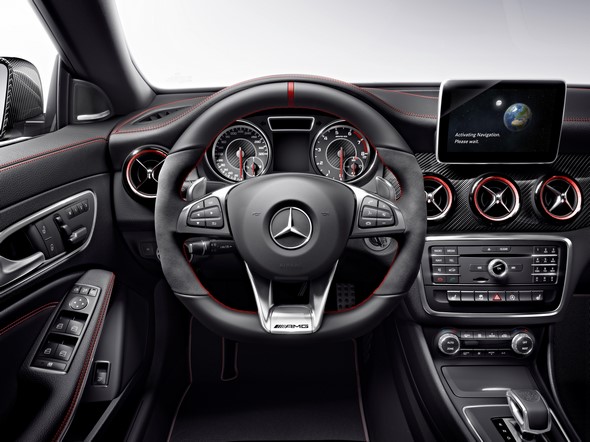
The head restraints are integrated into the backrests on the driver’s and front passenger seat and help protect against injuries to the cervical spine in a rear impact.
In critical situations: preventive PRE-SAFE® protective measures
The PRE-SAFE® anticipatory occupant protection system is available in the CLA-Class as an option. The system offers the car occupants optimum protection through preventive measures in case an accident should occur.
In order to do this PRE-SAFE® permanently evaluates the sensor data from other systems such as the Electronic Stability Program ESP® and the Brake Assist BAS and can therefore, for example, register unusually heavy under- or oversteering and emergency braking.
If a critical driving situation is detected, PRE-SAFE® can initiate various functions in fractions of a second.
In the CLA these include the reversible belt tensioning for the driver’s and front passenger seat plus the automatic closing of open side windows and the optional panoramic sliding sunroof.
After an accident: automatic emergency call and rapid rescue
After an accident various measures can lessen the consequences of an accident and facilitate rapid rescue.
This includes unlocking the doors and lowering the front side windows by 50 millimetres, so that the interior is better ventilated following activation of the airbags.
Depending on the type of accident and the severity of the impact the fuel pump is switched off. The hazard warning lamps are automatically switched on, as is the emergency lighting for better orientation in the interior.
In an accident, the Mercedes-Benz emergency call system, a “Mercedes connect me” service, automatically connects the occupants with the Mercedes-Benz Emergency Call Centre and sends the position and condition of the vehicle to the rescue operations centre.
A rescue vehicle can then be dispatched immediately. The system works automatically, but can also be triggered manually.
Under the microscope: COLLISION PREVENTION ASSIST reduces the number of accidents
Up to 30 percent fewer rear-end collisions
The new CLA Shooting Brake boasts COLLISION PREVENTION ASSIST PLUS as standard. Accident researchers at Mercedes-Benz anticipate that this feature could cut the number of serious rear-end collisions by up to
30 percent compared with vehicles that do not have a corresponding protective system.
For their prognosis, the safety experts used figures from Germany’s Federal Statistical Office to assess how effective standard-fit COLLISION PREVENTION ASSIST has been in the new compact-class cars to date and simulated digital accident data.
A comparison was made using accident figures for the current B-Class and the predecessor model. The official figures show that the number of serious rear-end collisions with Mercedes-Benz B-Class vehicles has gone down by 14 percent in Germany by comparison with the predecessor model.
The present B-Class was the first model in the new compact model series and has been equipped with COLLISION PREVENTION ASSIST as standard since its market launch in 2011.
This safety system includes a radar-based, visual distance warning signal, an additional acoustic collision warning and selective brake boost courtesy of Adaptive Brake Assist.
It is standard equipment for all vehicles in the new generation of compact cars (A-Class, B-Class, CLA and GLA), as well as many other vehicles from Mercedes-Benz.
This is substantiated by figures from Mercedes-Benz service outlets: by comparison with the previous model, the present B-Class has experienced much less serious damage to the front end when the front cross member needed to be replaced.
The severity of many rear-end collisions was therefore reduced, and in some cases they were avoided entirely.
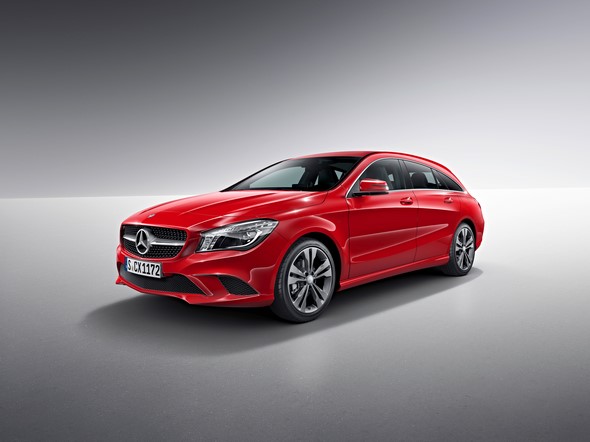
In a study, accident researchers at Mercedes-Benz came to the conclusion that up to 20 percent of all serious rear-end collisions in Germany could be prevented if all vehicles were fitted with an equivalent safety system.
Their claim is based on a simulation study using a pre-crash matrix – a digital accident database from the Traffic Accident Research Institute in Dresden containing thousands of carefully reconstructed, real-life accidents.
As part of this study, vehicles were equipped virtually with COLLISION PREVENTION ASSIST and its effects on each rear-end collision were examined.
For the enhanced successor system, COLLISION PREVENTION ASSIST PLUS, which is set to be rolled out across all model series, and which is available in the CLA Shooting Brake as standard right from the outset, the accident researchers are forecasting up to 30 percent fewer serious rear-end collisions than without the system.
COLLISION PREVENTION ASSIST PLUS extends the functionality of COLLISION PREVENTION ASSIST with autonomous braking to reduce the risk of rear-end collisions.
If the driver fails to act when a risk of collision is detected, despite the warning lamp in the instrument cluster and the intermittent acoustic alert, the system will automatically trigger braking.
The vehicle speed is thus already significantly reduced. Depending on the relative speed, this intervention may be enough to avoid a rear-end collision with vehicles that are driving more slowly, stopping or stationary, or significantly mitigate its severity.
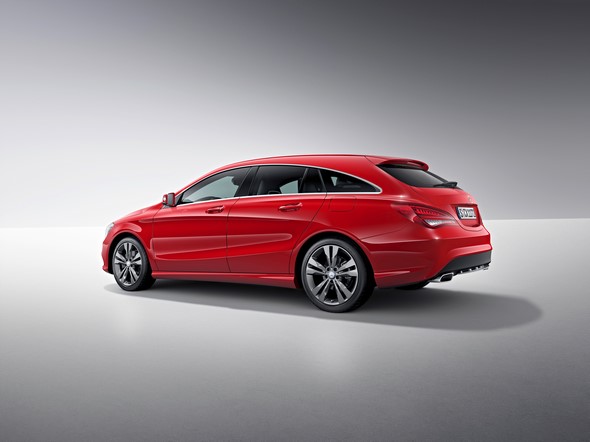
Engines and transmissions
Dynamic and exemplarily clean
The engine range available with the CLA Shooting Brake is extensive right from the start of sales, comprising two diesel and four petrol units.
All engines impress with their agile performance, low noise levels and low emissions. Over and above this, all versions are equipped as standard with the ECO start/stop function and are Euro 6-compliant.
Dynamic to drive, extremely efficient and exemplarily clean are apt descriptions for both diesel models – in the CLA 200 CDI and the CLA 220 CDI, which is available exclusively in combination with the dual clutch transmission 7G-DCT. Both engines have a displacement of 2.2 litres.
The engine in the CLA 200 CDI has an output of 100 kW (136 hp) and a maximum torque of 300 Nm.
The combined fuel consumption, from 3.9 litres of diesel per 100 kilometres (CLA 200 CDI with 7G-DCT, with a manual transmission: 4.1 l), is excellent for this output class.
The 130 kW (177 hp) top diesel in the CLA 220 CDI has a maximum torque of 350 Nm.
The performance, including 8.3 seconds for the standard sprint and 228 km/h maximum speed, is at a sporty level. With 105 g CO2 per kilometre and combined consumption of 4.0 l/100 km the CLA 220 CDI also sets benchmarks in its segment.
The CLA 200 CDI and CLA 220 CDI are categorised in efficiency class A+.
All-wheel drive variants in the form of the CLA 200 CDI 4MATIC and CLA 220 CDI 4MATIC will follow in September 2015.
An overview of the data for the CLA with a diesel engine:
| Diesel | CLA 200 CDI | CLA 220 CDI |
| Number of cylinders/arrangement | 4 in-line | 4 in-line |
| Displacement (cc) | 2143 | 2143 |
| Rated output (kW/hp at rpm) | 100/136 at 3200-4000 | 130/177 at 3600-3800 |
| Rated torque (Nm at rpm) | 300 at 1400-3000 | 350 at 1400-3400 |
| Combined fuel consumption from (l/100 km) | (4.2-3.9) 4.4-4.1 | (4.3-4.0) |
| Combined CO2 emissions from (g/km) | (111-101) 115-108 | (112-105) |
| Efficiency class | (A+) A+ | (A+) |
| Acceleration 0-100 km/h (s) | (9.9) 9.9 | (8.3) |
| Top speed (km/h) | (215) 215 | (228) |
Figures for version with 7G-DCT dual clutch transmission in parentheses; The entry-level model in the petrol range is the CLA 180, whose 1595 cc engine boasts a rated output of 90 kW (122 hp).
The state-of-the-art four-cylinder unit offers a maximum torque of 200 newton metres, which is available in a wide engine speed range from 1250 to 4000 rpm.
The fuel consumption and CO2 emissions, at 5.3 l/100 km, NEDC combined, and 124 g/km respectively, are at a record-breakingly low level (data for version with 7G-DCT, values for manual-transmission variant: 5.5 l/100 km/128 g/km).
The CLA 200 with a displacement of 1595 cc also develops 115 kW (156 hp) and maximum torque of 250 Nm, which is also available from 1250 to 4000 rpm.
It sprints from zero to 100 km/h in 8.7 seconds and has a top speed of 225 km/h, but gets by on an average of 5.3 l/100 km of fuel, meaning CO2 emissions of 124 g/km (data for version with 7G-DCT, values for manual-transmission variant: 5.6 l/100 km/130 g/km).
The sportiest engine this side of the CLA 45 AMG, with a displacement of 1991 cc, is the CLA 250. The engine develops 155 kW (211 hp) and maximum torque of 350 Nm from 1200 to 4000 rpm.
Performance is at sports car level, with acceleration from 0 to 100 km/h in 6.9 seconds and a top speed of 240 km/h. Nonetheless it has the best fuel consumption in this class at 5.5 l/100 km and CO2 emissions of 128 g/km.
All-wheel drive is available straight from the market launch in the CLA 250 4MATIC and CLA 250 Sport 4MATIC (features include: dynamic styling, sporty tuning of engine, accelerator and transmission as well as sporty engine sound; see model chapter).
All-wheel drive is of course also standard with the CLA 45 AMG top model (see separate press kit).
An overview of the data for the CLA with a petrol engine:
| Petrol | CLA 180 | CLA 200 | CLA 250 | CLA 250 4MATIC | CLA 45 AMG 4MATIC |
| Number of cylinders/arrangement | 4 in-line | 4 in-line | 4 in-line | 4 in-line | 4 in-line |
| Displacement (cc) | 1595 | 1595 | 1991 | 1991 | 1991 |
| Rated output (kW/hp at rpm) | 90/122 at 5000 | 115/156 at 5300 | 155/211 at 5500 | 155/211 at 5500 | 265/360 at 6000 |
| Rated torque (Nm at rpm) | 200 at 1250-4000 | 250 at 1250-4000 | 350 at 1200-4000 | 350 at 1200-4000 | 450 at 2250-5000 |
| Fuel consumption (combined) from (l/100 km) | 6.0-5.5 (5.6-5.3) | 6.0-5.6 (5.6-5.3) | (5.7-5.5) | (6.8-6.6) [6.8] | (6.9) |
| Combined CO2 emissions from (g/km) | 140-128 (132-124) | 140-130 (132-124) | (132-128) | (156-152) [158] | (161) |
| Efficiency class | B (B) | B (B) | (B) | (C) [C] | (C) |
| Acceleration 0-100 km/h (s) | 9.4 (9.3) | 8.8 (8.7) | (6.9) | (6.8) [6.8] | (4.7) |
| Top speed (km/h) | 210 (210) | 225 (225) | (240) | (240) [240] | (250)* |
Figures for version with 7G-DCT dual clutch transmission in parentheses (in square brackets:
CLA 250 Sport 4MATIC); *electronically limited;
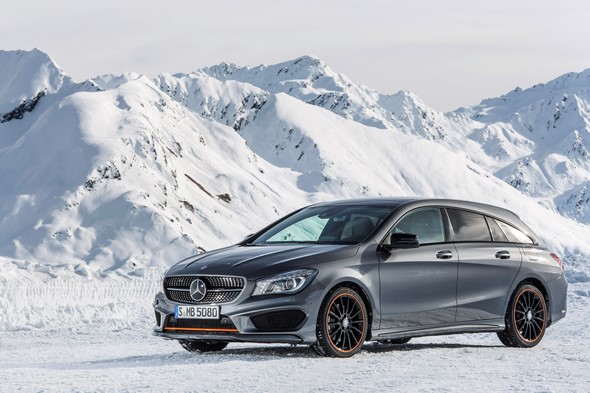
The transmissions: shifting comfort coupled with efficiency
A comfortable yet dynamic driving style is possible thanks to the dual clutch transmission 7G-DCT and the six-speed manual transmission.
The 7G-DCT dual clutch transmission is extremely compact, extremely variable with regard to adaptation of the engine speed thanks to seven gears, and incorporates an electric oil pump for start/stop capability.
It shifts gears without any interruptions in tractive power and combines the comfort of an automatic with the efficiency of a manual transmission.
The 220 CDI and CLA 250 plus all the 4MATIC variants are equipped as standard with the 7G-DCT transmission, which is optionally available for the CLA 200 CDI, CLA 180 and CLA 200 CDI.
Under the microscope: 4MATIC
Just a moment
On request the CLA Shooting Brake boasts the all-wheel drive system 4MATIC with fully variable torque distribution.
The CLA 250 4MATIC and CLA 250 Sport 4MATIC are available from the market launch.
Two further all-wheel drive variants will follow in September 2015 in the form of the CLA 200 CDI 4MATIC and CLA 220 CDI 4MATIC.
The innovative components of the 4MATIC include the power take-off to the rear axle, which is integrated into the 7G-DCT automated dual clutch transmission, and the rear-axle gear unit with its integral hydraulically actuated multi-disc clutch.
This set-up allows fully variable distribution of the drive torque between the front and rear axles. Additional benefits of this design are a lower system weight compared with the competition and also high efficiency.
As with their front-wheel-drive counterparts, all 4MATIC models also boast good energy efficiency.
Integrated power take-off unit (PTU) channels power to the rear axle
The 4MATIC is combined with the 7G-DCT seven-speed automated dual clutch transmission.
The power flow to the rear drive train is provided by a compact power take-off unit (PTU) which is fully integrated into the main transmission and supplied with lubricant from the latter’s oil circuit.
This configuration gives rise to substantial weight advantages over competitor systems that branch off power by means of an add-on component with its own oil circuit.
In conjunction with the friction-minimised tapered roller bearings, the PTU thus achieves an excellent level of efficiency.
The low system weight of the 4MATIC system is not attributable solely to the PTU. Other weight-stripping measures include a compact rear-axle gear unit, inductively hardened, weight-optimised rear-axle side shafts and weight-optimised drive shafts.
The system weight of this 4MATIC is up to 25 percent lower than in the all-wheel-drive versions offered by the competition. The two-piece drive shaft is vibrationally decoupled.
An axially moving joint at the front compensates for longitudinal movements of the engine transmission unit, while an elastic flexible coupling reduces the intrusion of high-frequency gearing vibrations at the rear-axle gear unit.
To minimise crash loads, the drive shaft is fitted with an extendable element.
Torque-on-demand rear axle
The electrohydraulically actuated multi-disc clutch integrated into the rear-axle gear unit is responsible for fully variable torque distribution.
Fundamental operating principle: when the multi-disc clutch is open, the car is driven exclusively by the front axle. When the clutch is closed, the rear axle comes into play.
However, the drive torque can be shifted in fully variable mode between front and rear axle according to the given situation (torque on demand).
The system pressure to activate the rear axle is supplied in milliseconds by the gerotor pump that is integrated into the rear-axle gear unit.
The pump is activated automatically as soon as only minimal speed differences arise between front and rear axles, and pressure control and therefore torque control to the rear axle are performed by means of a proportioning valve integrated into the rear axle.
Motoring enjoyment thanks to intelligent control systems
The 4MATIC is activated according to the basic principle of “as often as necessary, as rarely as possible”. In other words: when the underlying conditions allow, the all-wheel drive CLA Shooting Brake models run in particularly economical front-wheel drive mode.
As soon as the driving situation requires, drive torque is channelled to the rear axle as appropriate.
The reverse process takes place just as quickly: as soon as additional drive torque is no longer necessary at the rear axle – e.g. in case of heavy braking manoeuvres with ABS intervention – the rear drive train is deactivated and torque is reduced to zero.
In case of impending understeer or oversteer under load, the drive torque is first of all distributed in such a way as to stabilise the vehicle.

Only if these measures fail to have a stabilising effect do the control systems adapted to the conditions of 4MATIC, such as ESP® or 4ETS, intervene and keep the vehicle on course.
With this strategy, the developers have managed to combine two key requirements defined in the performance specifications: optimum energy efficiency coupled with maximum dynamic handling and driving safety.
Suspension
Dedicated to dynamism
The chassis of the CLA Shooting Brake features a McPherson front axle and multi-link independent rear suspension.
Three control arms and one trailing arm per wheel manage the incoming forces. This means that longitudinal and lateral dynamics are independent of one another. The Direct-Steer system is standard in all versions.
Specific to the CLA is the elastic de-coupling of the rear axle carrier.
The measures include rubber bushes vulcanised onto the stabiliser, plus elastomer coatings for the coil springs, which facilitate effective noise de-coupling between the body and rear axle.
The connection between the shock absorber and the body is via an aluminium bearing at the top, which through its cardanically soft mount contributes to a reduction in friction in the damper and therefore to an improvement in response.
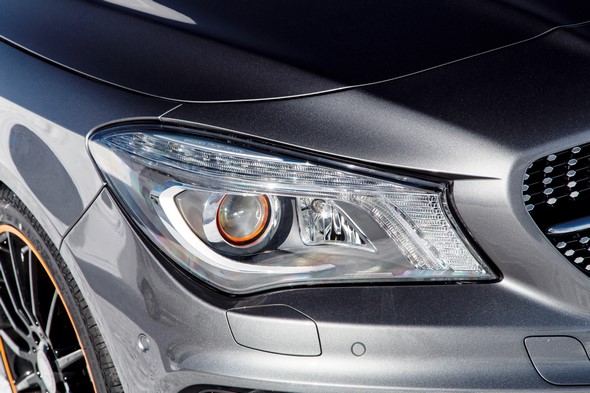
The wheel carriers and spring control arms are made of aluminium to reduce the unsprung masses.
These four chassis and suspension set-ups are available:
- Comfort suspension
- Lowered comfort suspension (standard in conjunction with Urban)
- Lowered sports suspension (standard in conjunction with AMG Line). Through the tauter configuration of the springs and damping the sports suspension facilitates a sportier driving style without any great loss of comfort.
- Sports suspension engineered by AMG. This suspension is also lowered and it is characterised by an independently developed AMG front and rear axle. In addition it includes larger-dimensioned stabilisers for high lateral acceleration and a reduced tendency to roll (standard for the CLA 250 Sport 4MATIC)
In the case of the lowered suspension variants the body is 15 mm lower at the front axle and 10 mm lower at the rear axle.
For no extra charge the Urban design and equipment line is also available on request with the comfort suspension, and likewise the AMG Line is alternatively available with the lowered comfort suspension.
Irrespective of the chassis, all CLA models (except the CLA 250 Sport) are fitted with the Sports Direct Steer system.
Compared to conventional systems, this electromechanical power steering provides better feedback to the driver and makes an important contribution to the vehicle’s overall efficiency, as the servo assistance only requires energy when the vehicle is actually being steered.
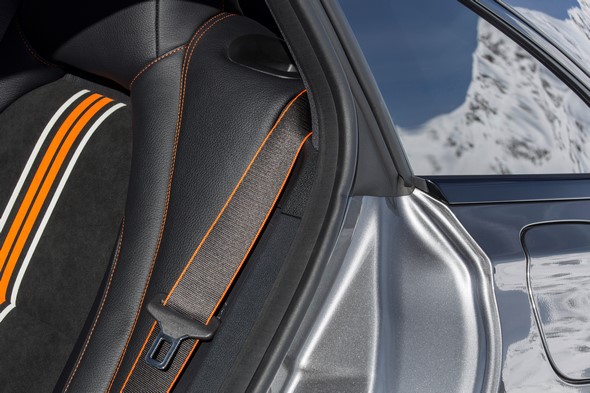
It also allows various steering assistance functions that are initiated by the ESP® control unit. These include countersteering when the vehicle oversteers, steering corrections when braking on surfaces with different levels of grip, reducing the effects of front-wheel drive on the steering and compensation of cross-winds and road camber.
The CLA 250 Sport includes the AMG speed-sensitive sports steering from the CLA 45 AMG.
With all engines the CLA features disc brakes all round. The floating callipers on the rear axle as well as the brake booster are made of aluminium.
An especially convenient feature is the HOLD function familiar from the larger model series: when stopping, for example at traffic lights, the driver merely has to press the brake pedal slightly more firmly once to keep the brake engaged until moving off again.
The brake is released automatically when the driver steps on the accelerator. In versions with manual transmission the Hill-Start Assist function is able automatically to prevent the vehicle from rolling back unintentionally when moving off on an uphill slope.
The CLA is equipped with an electric parking brake, which operates by means of actuator motors acting on the callipers of the rear axle.
The parking brake is activated via a button under the light switch on the left of the dashboard, freeing up space on the centre console where the handbrake lever would normally be.
If the button is pressed when travelling faster than 4 km/h, the parking brake functions as an emergency brake: all four wheel brakes are activated by the ESP® hydraulic unit.
In conjunction with the 7G-DCT automatic transmission, the parking brake offers a particularly convenient mode of functioning: when the driver accelerates sufficiently after fastening his seat belt, the parking brake is released automatically.
Multimedia systems
Entertainment, information and communication
The CLA Shooting Brake features the latest generation of telematics systems from Mercedes-Benz.
The free-standing display screen features a large screen diagonal of 17.8 cm (7 inches), together with a high-gloss piano-black front panel, a flush-fitting frame in Silvershadow and a fully glazed screen.
In combination with COMAND Online, or as an option for the Audio 20 system, the display is available with an even larger screen diagonal of 20.3 cm (8 inches).
The latest generation of COMAND Online (optional extra) includes the use of Remote Services and Live Traffic Information.
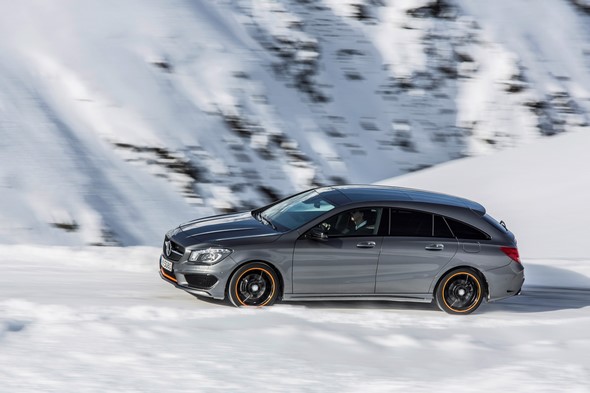
The latter service uses real-time traffic data for dynamic route guidance with more accurate arrival times. The information appears in high-resolution form and in colour on a 20.3 cm (8-inch) display.
The display is simple and intuitive to use. Rapid hard-disc navigation with realistic topographical map display leads the driver to their destination in a relaxed way.
In combination with an appropriate mobile phone it is possible to call up websites while the car is at a standstill and freely use Mercedes-Benz Apps such as POI search, weather or internet radio during the journey.
Entertainment as requested comes courtesy of a DVD player and radio plus interfaces for connecting external devices.
Further highlights of COMAND Online are the voice-operated control system LINGUATRONIC, a Bluetooth® interface with hands-free function, a reading function for text message plus music transmission via audio streaming.
Entertainment, information and communication are also offered by the Audio 20 USB (standard) and Audio 20 CD (optional extra).
The equipment features include internet capability, radio, twin tuner, two USB connections and networking with mobile devices via Bluetooth®.
As the name suggests, the Audio 20 CD also boasts a CD drive. From external audio devices MP3 and WMA as well as WAV and AAC files can be played via a USB connection – or in the case of the Audio 20 CD from a CD. The Cover Art function displays album covers in the audio menu.
With a Bluetooth®-capable mobile phone with a data option it is possible to call up websites while the car is at a standstill.
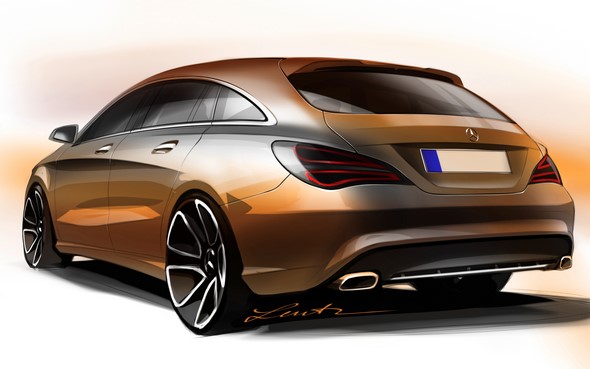
During the journey, too, the Mercedes-BenzApps “Mercedes-Benz Radio” and “Service Mercedes-Benz” (for Germany only) can be used freely.
The Bluetooth® interface has a hands-free function and audio streaming for playing music files. It also supports address transfer from the mobile phone to the head unit, as long as this supports the PBAP/Phonebook Access Profile function.
Bluetooth® telephony now features wideband speech. This technology transmits speech data with almost double the frequency spectrum.
This results in a clearly perceptible improvement in call quality, together with enhanced intelligibility. This function must be supported by the mobile phone provider.
Audio 20 CD is additionally available in a version with pre-installation for Garmin® MAP PILOT. The pre-installation comprises a GPS receiver, dead reckoning (compound navigation) and aerials.
The Audio 20 CD can thus simply and inexpensively be upgraded to become a fully-fledged navigation system.
For the Garmin® MAP PILOT transfers all the advantages of a Garmin® navigation system to the Audio 20 CD. All the driver needs to do for route guidance is to insert an SD card with navigation software and map data.
With twelve loudspeakers, including a woofer and a 9-channel DSP amplifier, the 450-watt Harman Kardon® Logic 7® surround sound system can on request ensure a rich sound experience in stereo, in DTS and Dolby Digital 5.1 format.
The surround sound system is available in conjunction with Audio 20 CD or COMAND Online.
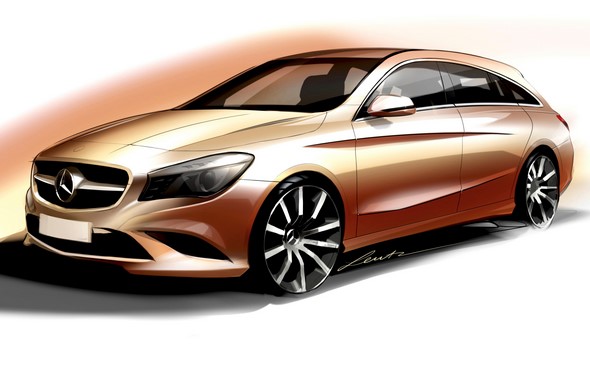
Mercedes connect me
In online contact with the car
“Mercedes connect me” links the CLA with the world around it. Mercedes connect me Standard Services can be used with the standard communications module.
Available services include, for example, Accident Recovery, Maintenance Management and Breakdown Management.
The Stuttgart-based premium automotive manufacturer has bundled its entire service portfolio under the umbrella brand “Mercedes me”, making services easily accessible and available at all times on a digital internet platform.
The line-up can be accessed via a personalised Mercedes ID on the www.mercedes.me website.
“Mercedes me” also includes new “Mercedes connect me” services. “Mercedes connect me” services can be used via a communications module integrated into the vehicle.
The available services include Accident Recovery, Maintenance Management and Breakdown Management.
Likewise, customers can connect to their vehicle from anywhere and at any time via “connect.mercedes.me” and, among other things, retrieve the fill level of the tank or start, stop or program the auxiliary heating system.
In an accident, the Mercedes-Benz emergency call system automatically connects the occupants with the Mercedes-Benz Emergency Call Centre and sends the position and condition of the vehicle to the rescue operations centre.
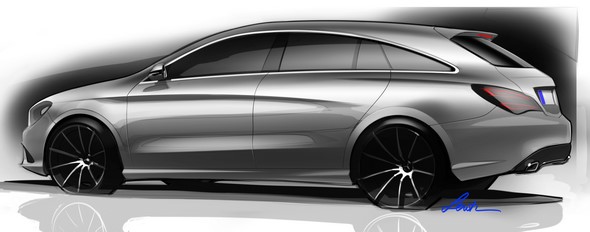
A rescue vehicle can then be dispatched immediately. The system works automatically, but can also be triggered manually.
“Mercedes connect me” Standard Services comprise:
- Accident Recovery – after the Mercedes-Benz emergency call, the system connects to the Customer Assistance Centre so that additional assistance can be requested, where necessary, to deal with an accident, e.g. a tow truck.
- Breakdown Management – provides technical assistance in the event of a breakdown. To this end, the position and condition of the vehicle are transmitted to the Customer Assistance Centre, which informs Mercedes-Benz Service 24h. This allows the Mercedes-Benz Service 24h to provide fast and optimal help.
- Maintenance Management – the vehicle detects and reports pending maintenance need and sends the necessary data to the service outlet as the basis for preparing a service quote.
- Telediagnostics – the vehicle detects the need for replacement of diagnostics-capable wear parts and reports this to the service outlet. The service outlet contacts the customer to arrange a workshop appointment. The previously transmitted data enable the workshop to provide optimal assistance.
The “Live Traffic Information” service comprises:
- real-time traffic data from TomTom in conjunction with COMAND Online – three-year term, can be extended after the end of the term for a fee.
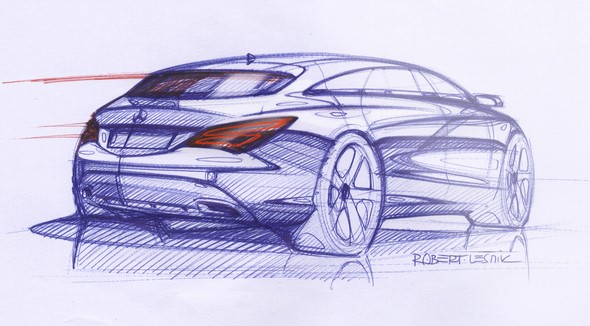
The optional Remote Online Services (can also be used with a smartphone via www.connect.mercedes.me) comprise:
- Parked Vehicle Locator – allows the vehicle position to be determined, for example, if the vehicle was parked in an unfamiliar city. This makes convenient finding of the vehicle within a range of 1.5 kilometres possible, using a smartphone.
- Vehicle Tracker – enables the latest position of a moving vehicle to be pinpointed via GPS. The driver has a display in the vehicle and can deactivate the service at any time with a toll-free call to the Customer Assistance Centre.
- Geofencing – displays where the vehicle is in an area previously defined on the map and informs the customer if the car leaves or enters this area. As in the case of the Vehicle Tracker, the driver can deactivate the service at any time (due to become available mid-2015).
- Remote Door Locking and Unlocking – allows the vehicle doors to be locked or unlocked remotely, for example, if the driver forgot to lock the vehicle (due to become available mid-2015).
- Remote Retrieval of Vehicle Status – vehicle data such as fuel level, range and more can be accessed from home or while on the road.
Programming of Auxiliary Heating – if the vehicle is equipped with auxiliary heating, all functions such as starting, switching off or programming of the timer can be controlled online via a smartphone.

